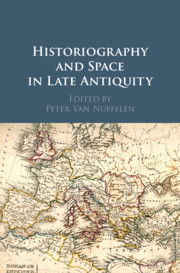Book contents
- Historiography and Space in Late Antiquity
- Historiography and Space in Late Antiquity
- Copyright page
- Contents
- Contributors
- Acknowledgements
- Introduction
- Chapter 1 Constantinople’s Belated Hegemony
- Chapter 2 Beside the Rim of the Ocean
- Chapter 3 Armenian Space in Late Antiquity
- Chapter 4 Narrative and Space in Christian Chronography
- Chapter 5 The Roman Empire in John of Ephesus’s Church History
- Chapter 6 Changing Geographies
- Chapter 7 Where Is Syriac Pilgrimage Literature in Late Antiquity?
- Bibliography
- Index
Chapter 3 - Armenian Space in Late Antiquity
Published online by Cambridge University Press: 12 August 2019
- Historiography and Space in Late Antiquity
- Historiography and Space in Late Antiquity
- Copyright page
- Contents
- Contributors
- Acknowledgements
- Introduction
- Chapter 1 Constantinople’s Belated Hegemony
- Chapter 2 Beside the Rim of the Ocean
- Chapter 3 Armenian Space in Late Antiquity
- Chapter 4 Narrative and Space in Christian Chronography
- Chapter 5 The Roman Empire in John of Ephesus’s Church History
- Chapter 6 Changing Geographies
- Chapter 7 Where Is Syriac Pilgrimage Literature in Late Antiquity?
- Bibliography
- Index
Summary
In late antiquity, there was no single conception of Armenian space. Instead, there were different notions of what constituted Armenia, each contingent on date, context and perspective. For authors operating within an Armenian cultural milieu, Armenian space was automatically defined in terms of the land occupied by an imagined community because the standard expression for the land of Armenia was ašxarh/erkir Hayoc‘, the homeland of the descendants of Hayk, the eponymous ancestor of the Armenian people.1 This social construction, therefore, created Armenian space wherever those who identified as Armenians were settled. It was not tied to a specific territory with fixed boundaries. At the same time, however, Armenian space was understood in terms of a political landscape, albeit a historic one, comprising the lands of the Arsacid kingdom before its demise in 428 AD.
- Type
- Chapter
- Information
- Historiography and Space in Late Antiquity , pp. 57 - 85Publisher: Cambridge University PressPrint publication year: 2019

